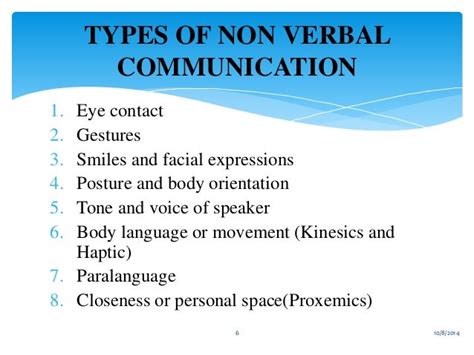List And Examples Of Nonverbal Communication Skills

Communication is not just about the words we say, but also about the way we say them. Nonverbal communication skills are the gestures, facial expressions, body language, and tone of voice that we use to convey our messages. These skills are an important part of interpersonal communication, and can greatly impact the effectiveness of our interactions with others. In this article, we will explore some of the key nonverbal communication skills and provide examples of how to use them effectively.
1. Eye Contact
Eye contact is a powerful nonverbal communication skill that can convey confidence, attentiveness, and respect. When speaking with someone, it is important to maintain regular eye contact to show that you are engaged in the conversation. However, be careful not to stare too intensely, as this can come across as aggressive or intimidating.
Example:
During a job interview, make sure to maintain regular eye contact with the interviewer to show that you are confident and interested in the position.
2. Body Language
Body language is another important nonverbal communication skill that can convey a wide range of emotions and attitudes. Posture, gestures, and facial expressions can all be used to communicate confidence, enthusiasm, or even boredom. Pay attention to your body language during conversations to ensure that your message is being conveyed effectively.
Example:
If you are feeling nervous during a presentation, try to maintain an upright posture and avoid fidgeting to convey confidence and professionalism.
3. Tone of Voice
The tone of your voice can also have a significant impact on the way your message is received. A friendly, upbeat tone can make your message more engaging, while a monotone or negative tone can be off-putting. Pay attention to your tone of voice and adjust it as necessary to match the context of the conversation.
Example:
When speaking with a customer service representative, try to maintain a calm and friendly tone to help diffuse any potential conflicts and convey empathy.
4. Facial Expressions
Facial expressions are a key part of nonverbal communication and can convey a wide range of emotions. Smiling, for example, can convey friendliness and approachability, while a furrowed brow can signal anxiety or anger. Pay attention to your facial expressions during conversations to ensure that they match the context of the interaction.
Example:
When meeting someone for the first time, try to smile and maintain a relaxed facial expression to convey warmth and openness.
5. Gestures
Gestures can also be an effective way to convey meaning and emotion in nonverbal communication. Hand gestures, for example, can be used to emphasize a point or convey enthusiasm. However, be mindful of cultural differences in gesture meanings to avoid miscommunication.
Example:
During a business presentation, use hand gestures to emphasize important points and help keep the audience engaged.
6. Proximity
Proximity, or physical distance, is another important aspect of nonverbal communication. Standing too close to someone can be seen as aggressive or invasive, while standing too far away can be seen as disinterest or coldness. Pay attention to the physical distance between yourself and others during conversations to ensure that it is appropriate for the context.
Example:
When speaking with a close friend, standing at a comfortable distance can help convey warmth and intimacy.
7. Touch
Touch can also be a powerful nonverbal communication skill, conveying emotions such as comfort, support, or aggression. However, it is important to be mindful of personal boundaries and cultural norms when using touch in communication.
Example:
A comforting pat on the back can convey support and empathy during a difficult conversation.
8. Appearance
Appearance is another important aspect of nonverbal communication, as it can convey a wide range of information about a person’s personality, values, and social status. Pay attention to your appearance during professional interactions to ensure that it conveys the appropriate message.
Example:
Dressing professionally for a job interview can convey professionalism and attention to detail.
9. Silence
Silence is also a powerful nonverbal communication skill, conveying emotions such as contemplation, discomfort, or agreement. Pay attention to moments of silence during conversations to determine their meaning and respond appropriately.
Example:
After making a difficult request, allowing a moment of silence can convey respect for the other person’s decision-making process.
10. Timing
Finally, timing is an important aspect of nonverbal communication, as it can convey urgency, politeness, or disrespect. Pay attention to the timing of your messages during conversations to ensure that they are received effectively.
Example:
When delivering bad news, timing the message appropriately can help soften the blow and convey empathy.
Conclusion
Nonverbal communication skills are an important part of effective interpersonal communication. By paying attention to our gestures, facial expressions, body language, and tone of voice, we can convey our messages more effectively and build stronger relationships with others.
FAQs
1. How can I improve my nonverbal communication skills?
You can improve your nonverbal communication skills by practicing active listening, paying attention to your body language, and getting feedback from others on how your messages are being received.
2. What are some common nonverbal communication mistakes to avoid?
Common nonverbal communication mistakes include avoiding eye contact, crossing your arms, and slouching. These behaviors can convey disinterest or defensiveness.
3. How can I use nonverbal communication to build stronger relationships?
You can use nonverbal communication to build stronger relationships by using positive body language, maintaining regular eye contact, and conveying empathy through your tone of voice and facial expressions.
* This article was written with reference to the work of Albert Mehrabian, a pioneer in the field of nonverbal communication.
